Dragging Core2Duo into 2013: Time for an Upgrade?
by Ian Cutress on January 15, 2013 12:30 PM EST- Posted in
- CPUs
As any ‘family source of computer information’ will testify, every so often a family member will want an upgrade. Over the final few months of 2012, I did this with my brother’s machine, fitting him out with a Sandy Bridge CPU, an SSD and a good GPU to tackle the newly released Borderlands 2 with, all for free. The only problem he really had up until that point was a dismal FPS in RuneScape.
The system he had been using for the two years previous was an old hand-me-down I had sold him – a Core2Duo E6400 with 2x2 GB of DDR2-800 and a pair of Radeon HD4670s in Crossfire. While he loves his new system with double the cores, a better GPU and an SSD, I wondered how much of an upgrade it had really been.
I have gone through many upgrade philosophies over the decade. My current one to friends and family that ask about upgrades is that if they are happy installing new components. then upgrade each component to one of the best in its class one at a time, rather than at an overall mediocre setup, as much as budget allows. This tends towards outfitting a system with a great SSD, then a GPU, PSU, and finally a motherboard/CPU/memory upgrade with one of those being great. Over time the other two of that trio also get upgraded, and the cycle repeats. Old parts are sold and some cost is recouped in the process, but at least some of the hardware is always on the cutting edge, rather than a middling computer shop off-the-shelf system that could be full of bloatware and dust.
As a result of upgrading my brother's computer, I ended up with his old CPU/motherboard/memory combo, full of dust, sitting on top of one of my many piles of boxes. I decided to pick it up and run the system with a top range GPU and an SSD through my normal benchmarking suite to see how it faired to the likes of the latest FM2 Trinity and Intel offerings, both at stock and with a reasonable overclock. Certain results piqued my interest, but as for normal web browsing and such it still feels as tight as a drum.
The test setup is as follows:
Core2Duo E6400 – 2 cores, 2.13 GHz stock
2x2 GB OCZ DDR2 PC8500 5-6-6
MSI i975X Platinum PowerUp Edition (supports up to PCIe 1.1)
Windows 7 64-bit
AMD Catalyst 12.3 + NVIDIA 296.10 WHQL (for consistency between older results)
My recent testing procedure in motherboard reviews pairs the motherboard with an SSD and a HD7970/GTX580, and given my upgrading philosophy above, I went with these for comparable results. The other systems in the results used DDR3 memory in the range of 1600 C9 for the i3-3225 to 2400 C9 for the i7-3770K.
The Core2Duo system was tested at stock (2.13 GHz and DDR2-533 5-5-5) and with a mild overclock (2.8 GHz and DDR2-700 5-5-6).
Gaming Benchmarks
Games were tested at 2560x1440 (another ‘throw money at a single upgrade at a time’ possibility) with all the eye candy turned up, and results were taken as the average of four runs.
Metro2033
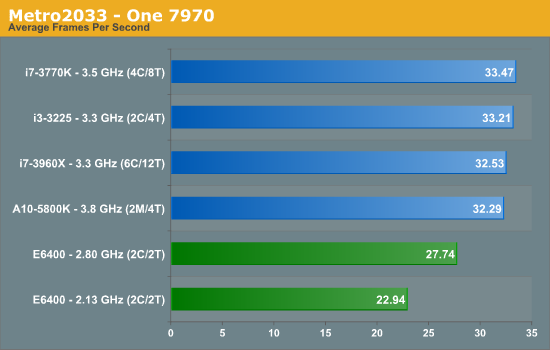
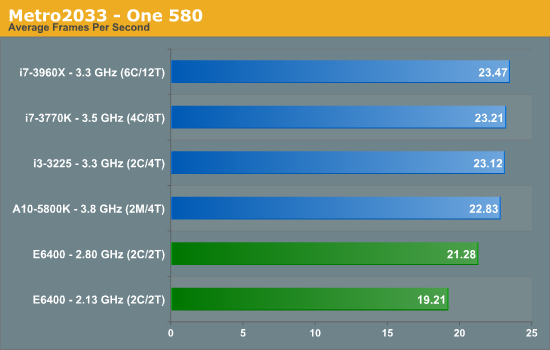
While an admirable effort by the E6400, and overclocking helps a little, the newer systems get that edge. Interestingly the difference is not that much, with an overclocked E6400 being within 1 FPS of an A10-5800K at this resolution and settings while using a 580.
Dirt3
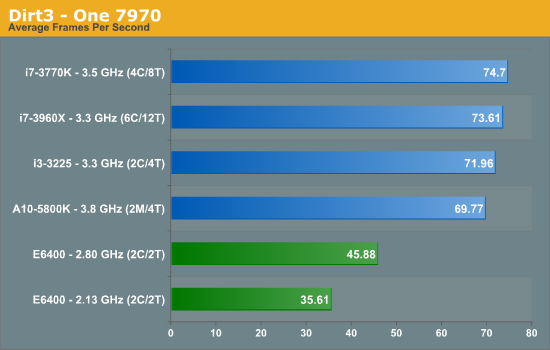

The bump by the overclock makes Dirt3 more playable, but it still lags behind the newer systems.
Computational Benchmarks
3D Movement Algorithm Test
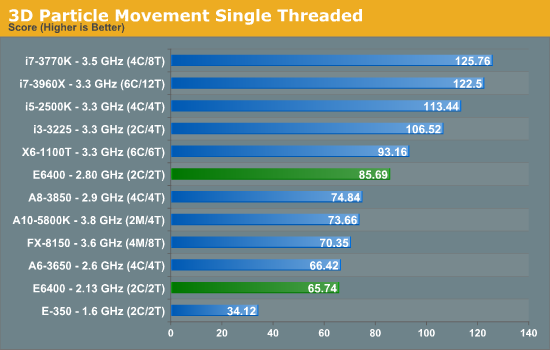
This is where it starts to get interesting. At stock the E6400 lags at the bottom but within reach of an FX-8150 4.2 GHz , but with an overclock the E6400 at 2.8 GHz easily beats the Trinity-based A10-5800K at 4.2 GHz. Part of this can be attributed to the way the Bulldozer/Piledriver CPUs deal with floating point calculations, but it is incredible that a July 2006 processor can beat an October 2012 model. One could argue that a mild bump on the A10-5800K would put it over the edge, but in our overclocking of that chip anything above 4.5 GHz was quite tough (we perhaps got a bad sample to OC).
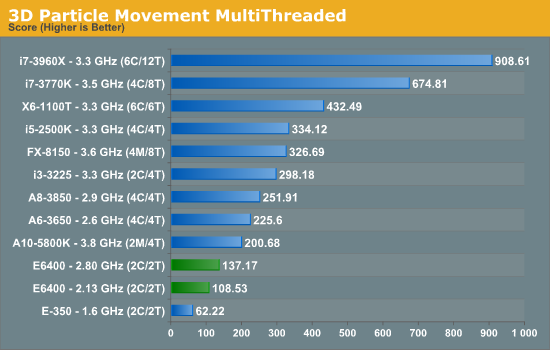
Of course the situation changes when we hit the multithreaded benchmark, with the two cores of the E6400 holding it back. However, if we were using a quad core Q6600, stock CPU performance would be on par with the A10-5800K in an FP workload, although the Q6600 would have four FP units to calculate with and the A10-5800K only has two (as well as the iGPU).
WinRAR x64 3.93 - link

In a variable threaded workload, the DDR2 equipped E6400 is easily outpaced by any modern processor using DDR3.
FastStone Image Viewer 4.2 - link
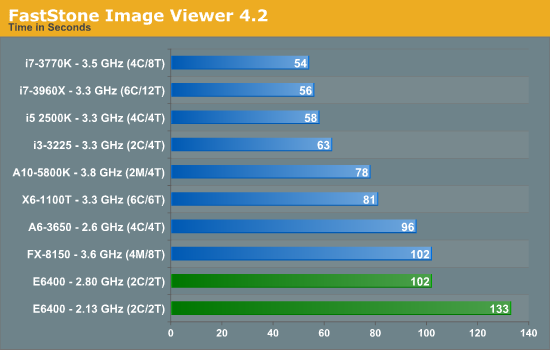
Despite FastStone being single threaded, the increased IPC of the later generations usually brings home the bacon - the only difference being the Bulldozer based FX-8150, which is on par with the E6400.
Xilisoft Video Converter
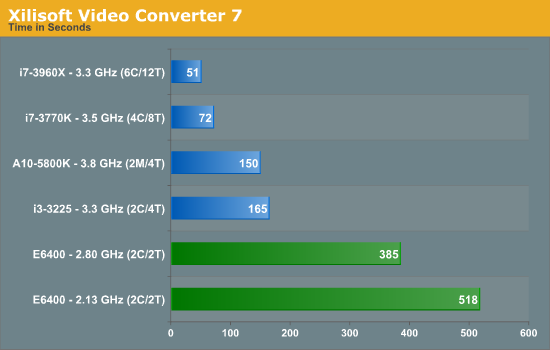
Similarly with XVC, more threads and INT workloads win the day.
x264 HD Benchmark
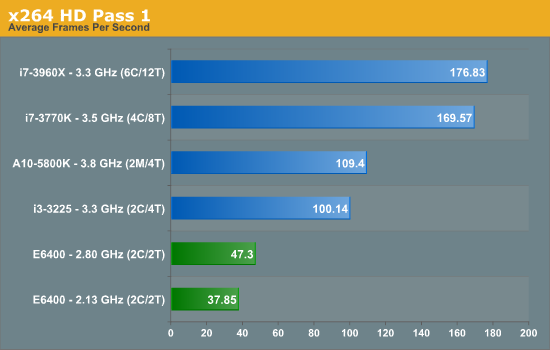
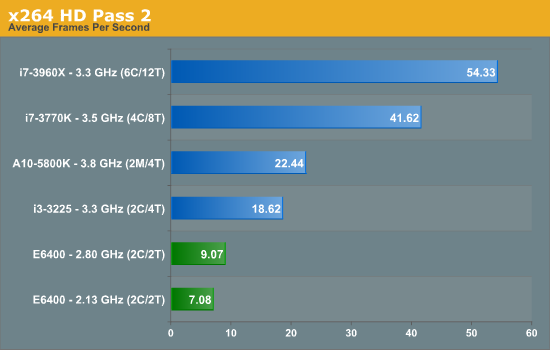
Conclusions
When I start a test session like this, my first test is usually 3DPM in single thread mode. When I got that startling result, I clearly had to dig deeper, but the conclusion produced by the rest of the results is clear. In terms of actual throughput benchmarks, the E6400 is comparatively slow to all the modern home computer processors, either limited by cores or by memory.
This was going to be obvious from the start.
In the sole benchmark which does not rely on memory or thread scheduling and is purely floating point based the E6400 gives a surprise result, but nothing more. In our limited gaming tests the E6400 copes well at 2560x1440, with that slight overclock making Dirt3 more playable.
But the end result is that if everything else is upgraded, and the performance boost is cost effective, even a move to an i3-3225 or A10-5800K will yield real world tangible benefits, alongside all the modern advances in motherboard features (USB 3.0, SATA 6 Gbps, mSATA, Thunderbolt, UEFI, PCIe 2.0/3.0, Audio, Network). There are also significant power savings to be had with modern architectures.
My brother enjoys playing his games at a more reasonable frame rate now, and he says normal usage has sped up by a bit, making watching video streams a little smoother if anything. The only question is where Haswell will come in to this, and is a question I look forward to answering.


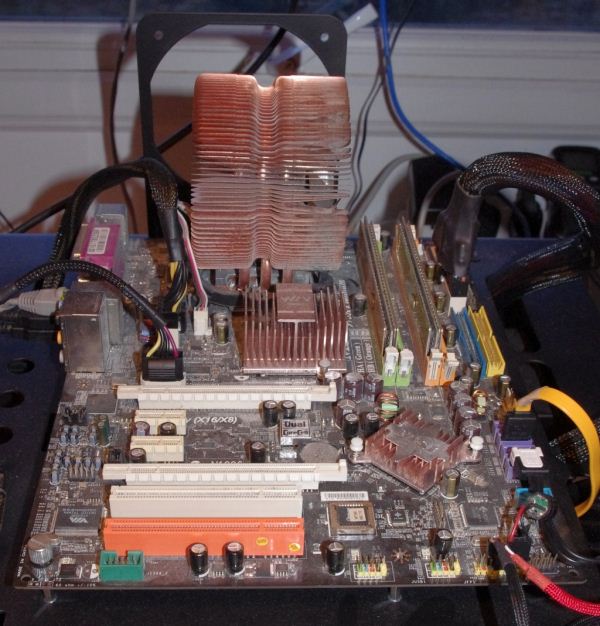








136 Comments
View All Comments
cjs150 - Friday, January 18, 2013 - link
Buy your brother a vacuum cleaner!It all depends on what you want. I have a very nice 21" monitor that I bought 5 years ago that only runs at 1680 resolution not 1920x1080. Nvidia 8800 GT I have had for years is more than adequate for most games I play.
On the other hand, an Atom netbook I have had for about 3 years is incredibly and frustratingly slow.
Movieman420 - Saturday, January 19, 2013 - link
Another area were the e8400 held/holds it's weight was encoding with that big 6MB cache. Re-encoded mannnny vids with it at 4.3GHz using a thermalright 120 hsf w/ no probs even when doing other stuff. Was the mutts nutts till the Q6600 launched and smoked everything.to keep up the rant...before you sell off or give away an older system...
PLEASE try running it with an ssd boot drive....any size will do! ;)
snarfbot - Saturday, January 19, 2013 - link
should have used crysis instead, a core 2 duo even overclocked to 3.5ghz bottlenecks a 4890. i just upgraded recently and the performance increase was pretty staggering, even with the ancient gpu.bf3 played better too, all the stutters and momentary hitches disappeared and it was just alot smoother overall.
even source games play alot better. instead of dipping to the 40's for instance in csgo my fps remained pegged over 100.
gta 4 is finally playable, after all these years.
i ended up getting a 7950, and i cant imagine how poorly it would have done on the old system, which was faster than the processor in the article. so yea.
Eyefinity - Saturday, January 19, 2013 - link
It's worth pointing out how close the 5800K is to the 3770K in gaming, especially when you're pointing out that the overclocked E6400 is "within 1 fps" (which it isn't really, it's 1.5 fps).silverblue - Monday, January 21, 2013 - link
Unfortunately, AMD's only hopes for equal performance in most games is to push the load onto the GPU. Throw in a second GPU and a huge gap appears, max details or not.Navvie0 - Saturday, January 19, 2013 - link
Really interesting, thought provoking article.I realise the C2D on test was essentially gifted, but if you had access to a C2Q processor I'd find that article extremely beneficial.
LancerVI - Wednesday, January 23, 2013 - link
Would've been nice to see a 920 included.Just saying.
pandemonium - Wednesday, January 30, 2013 - link
It's nice to see reviews like this, coming from reviewers. It brings things down to earth for the every-day, average end-user.I would like to note that the significance of power consumption, while not exactly glossed over by the author, but not expressly noted with data either, is really where the bottom line is going to be. I mean, even in the last 2 generations of hardware, power consumption has dropped dramatically, while still maintaining a small, if not noteworthy increase in performance. To me, this is the more important selling point of newer hardware, than anything.
Either way, I certainly appreciate the time spent to reaffirm common knowledge in the component world. :)
Manoa - Wednesday, February 13, 2013 - link
I wouldn't count core 2 out just yet, I have a core 2, and it's doing a hell of job keeping my crysis 2 (with high-res and MaLDo in dx11 mode with everything on the very highest) min fps at 20. I would only add that a highly overclocked core 2 (whether 45 or 65 nm) is not only for browsing, and people don't throw them away or count them out so fast, they are fast. I did some benchmarks of my own and found out that my core 2 at it's current mhz (overclocked to the maximum) is about equal to the performance of an i3 (I suspect a penryn at over 3600 mhz would be faster than i3), and also in the games that performance does matter, it's more often a graphics card problem and not (as it used to be in the pre-core 2 era) the processor. if you are asking me core 2 at stock or i3, then i3 for sure, but I think most people who visit this site are not about stock clock :)faster - Sunday, February 17, 2013 - link
I also have many people who come to me to upgrade their systems. For many of these people who had core2Duo's, I merely upgraded them to Windows7, added more memory, gave them a SSD boot drive, and used their old drive as a storage drive. Some got upgraded video cards depending on thier needs.The vast majority of people feel like they got a brand new faster computer for less money than a full upgrade would cost them. Anecdotal evidence is great, but seeing the numbers quantified in this article was very interesting. It makes me wonder how a E8400 @ 3.0 Ghz would fare or perhaps a Core2Quad Q9650 @ 3.0 Ghz. Pair one of these processors with a GTX680 and see how they handle the gambit of modern games. I would like to see if they would render decent enough framerates to put off an upgrade and justify spending $500 on a video card.